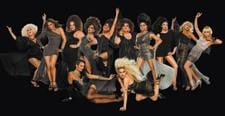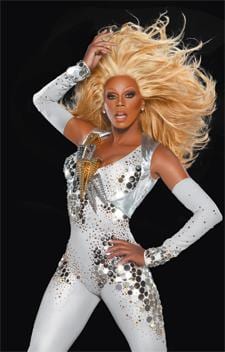
For more on RuPaul's Drag Race and for a chance to enter RuPaul's Drag Race Fantasy, visit outtv.ca
I remember my sisters talking about RuPaul back when “Supermodel (You Better Work)” was released in 1993. I was 12 years old and obsessed with all things Australian, so I thought they were talking about a cartoon kangaroo named Paul. When I finally saw the music video, I was disappointed to learn that Kangaroo Paul actually appeared to be a giant black woman.
It seemed to my prepubescent brain that RuPaul ruled over some part of New York City like a bizzaro US version of Queen Elizabeth II, which, to me, was pretty amazing. Despite having legs for days, she was also a man, which confused me even further.
It’s 9:35am and RuPaul is on the line from her Los Angeles office. She asks if I was up late the night before and whether my evening “included lube or Jergens lotion.” She is quick to address my pre-teen confusion and the effect her gender-fucking has on popular culture.
“You would think that the hostility towards drag through the ages was because of the gay thing,” she says. “It’s really not. The reason there’s hostility towards drag is because drag queens remind people to not take themselves so seriously. [We] tell people, ‘Who you think you are, you really aren’t.’”
Eighteen years after my first RuPaul experience, I realize I share something with millions of others worldwide: RuPaul popped our drag cherries and she hasn’t looked back since. And, perhaps surprisingly, she isn’t arrogant or egotistical about it.
“I feel like I’ve done that, but it was never what I set out to do,” RuPaul confesses. “If people can get something out of it, I say, ‘Right on, lady! Lift up your skirt and fly.’ But first and foremost, I’m doing this because I dig it and have a great time.”
Even after 29 years of performance she isn’t slowing down. She is one of the busiest and most successful drag queens around.
“I’m making an album,” she tells me. This is coming off an intense year of promoting her latest book, Workin’ It!: RuPaul’s Guide to Life, Liberty and the Pursuit of Style and filming and promoting her two hit shows, RuPaul’s Drag Race and RuPaul’s Drag U.
Drag Race, which originally aired on Logo in the US, is one of that network’s most popular shows.
“I think people have been hungry for a show like Drag Race for the past 10 years,” RuPaul explains. “After 9/11, this country became very dour, took itself very seriously. Drag is really the antithesis of that.”
She’s upping the ante with the show’s third season, which premieres Jan 24 at 9pm on OUTtv here in Canada. This year’s “contestants are on such a higher level of competition than before,” she says. “These are absolutely by far the best queens working in America today.”
In a career full of surprises, she is content, for now, with changing the future as we know it one drag queen at a time.
“Honey, if you can’t laugh, you know you’re in serious trouble,” she tells me, her voice as slick as two Jergens-moisturized thumbs up and packed with double finger snaps.

 Why you can trust Xtra
Why you can trust Xtra


